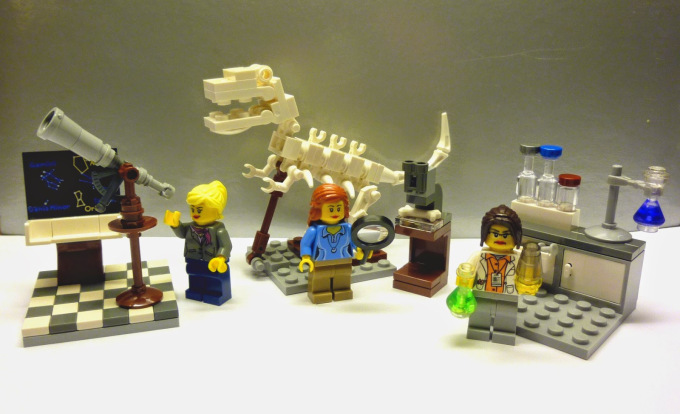
Computer Engineer Barbie, meet LEGO women scientists. This summer a new, limited edition LEGO® Research Institute went on sale including a paleontologist with her dinosaur skeleton, magnifying glass and microscope, a chemist with her minilab and flasks, and an astronomer with her telescope and star chart. The set was the brainchild of geochemist Ellen Kooijman from the Swedish Museum of Natural History. Her design was greenlighted after it garnered at least 10,000 votes from fans on the LEGO Ideas website.
The set has quickly sold out on certain sites, but an online petition effort is trying to get the Research Institute reissued, so it can become a permanent part of the LEGO pantheon. One aspect of the set would need finetuning though, says Kooijman, who heads a national laboratory at the Swedish museum. “I’m surprised they didn’t give the chemist protective gloves. In my personal version I will definitely change that, because safety comes first!”
Kooijman has been building with LEGO® bricks for more than ten years. The idea for a set of women scientist figures came to her while she was surfing the web for inspiration.
"As a female scientist I had noticed two things about the available LEGO sets: a skewed male/female minifigure ratio and a rather stereotypical representation of the available female figures. It seemed logical that I would suggest a small set of female minifigures in interesting professions to make our LEGO city communities more diverse."
Toys like the new women scientist figures help encourage girls to pursue science careers, Kooijman believes. "Girls should build up confidence at an early age that they are perfectly equipped for a scientific career. It is very stimulating to hear about examples of successful women in science and their accomplishments. Good female role models may make it easier for girls to imagine that they could achieve a similar thing."
Kooijman has been interested in natural sciences since she was very young. She was particularly fascinated by astronomy when her parents took her to a planetarium.
"I think it is important to encourage children to ask as many questions as possible about the world around them," she urges parents and teachers. "A good way of stimulating interest in science is by showing how much fun it can be, for example by doing science-related crafts projects, or going to science and technology activity museums aimed at children where they learn by doing fun experiments."
In the laboratory, Kooijman and her team do chemical analyses of all kinds of Earth materials such as rocks, sediments, soils and water, as well as bones and synthetic materials. At Howtosmile.org, one of the most popular of all activities is LEGO® Chemical Reactions. This activity uses LEGO® bricks to represent atoms bonding into molecules and crystals. The activity has a "wet lab" chemistry experiment (mixing baking soda and calcium chloride with phenol red indicator), followed by a "LEGO lab" modeling phase that includes writing formulas using chemical notation.
Both girls and boys can have fun while they're learning with LEGO activities at Howtosmile.org. They can explore chemical reactions, investigate structures and properties of the nanoworld, design robots, create art, engineer castles, models NASA's Kepler mission to discover new exoplanets, and even recreate the science of favorite stories like The Three Little Pigs.
If you can't get hold of the new LEGO set for your favorite learner, girl or boy, the American Association of University Women (AAUW), a Howtosmile.org national partner, publishes an annual Gift Guide for Girls. This list recommends the best gifts "that defy stereotypes, encouraging girls (and why not boys, too?) to explore the whole range of hobbies and careers including sports, science, and engineering."
